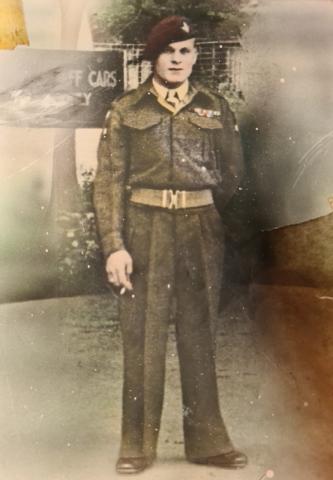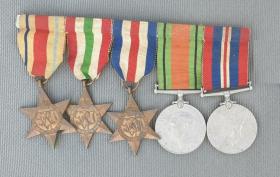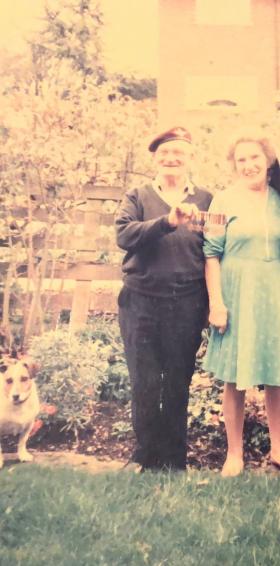Henry Arthur Webber was born on the 12 July 1922. ‘He was born in Gateshead, Tyne & Wear, he came from a large family. He left Gateshead to join the Army as he didn’t want to go into mining. We knew he joined the Army before the legal age, but we weren’t aware he was discharged because of this. He spoke and at times sang in German.’ [4]
Henry, always known as ‘Harry’, enlisted into The Durham Light Infantry on the 13th August 1940. [1]
However, he appears to have been discharged on the 30 September 1940 (possibly for being under age), and is then re-enlisted into The Royal Northumberland Fusiliers on the 1 October 1940. He remains with this Regiment until the 28 December 1940, and the next day he is posted back to The Durham Light Infantry. He remains with them until the 26 May 1942, by which time he is serving with the 70th (Young Soldiers) Battalion, The Durham Light Infantry. [1] & [2]
On the 27 May 1942 he is posted to The Parachute Regiment, and sent to Hardwick Hall. [2]
Having volunteered for Airborne Forces, and passing the selection and initial ground training phase at Hardwick Hall, he was sent on Parachute Course 15, at RAF Ringway, 8 to 16 June 1942. He completed the Long Course of two descents from balloon and five from a Whitley aircraft, to qualify as an Army Parachutist. [3]
Although he is listed on the Parachute Course Report as being with the 1st Parachute Battalion, this appears to have been a mixed group of both 1st and 3rd Parachute Battalions.
Upon completion Harry was posted to ‘C’ Company, 3rd Parachute Battalion and assigned to 8 Platoon. With them he took part in Operation ‘TORCH’, which was the North African campaign from October 1942 to May 1943. He then took part in Operation ‘SLAPSTICK’ which was the 1st Airborne Division’s landing by a Royal Navy Force at the Italian port of Taranto, in September 1943.
In December 1943, Harry, along with the rest of the 3rd Parachute Battalion, returned to England and was initially billeted in Ruskington in Lincolnshire. On return from their leave in January 1944 they moved to Spalding in Lincolnshire, where they would remain until September 1944.
By the summer of 1944, 8 Platoon was commanded by Lt. Gerald Infield.
Pte. Henry Webber served in 5 Section at Arnhem, under the command of Sergeant. Charles Storey.
On Sunday, 17 September 1944, Henry takes off from Saltby aerodrome aboard a Dakota aircraft of the 314th Troop Carrier Group, USAAF. and is bound for DZ. ‘X’ near Renkum in Holland as part of Operation ‘MARKET-GARDEN’. He jumps successfully onto the drop zone and makes it to the RV.
The 3rd Parachute Battalion are to advance into Arnhem along the Utrechtseweg – codenamed route ‘TIGER’ – and reinforce the 2nd Parachute Battalion in defence of the main road bridge approx. 5 – 6 miles away. In the order of march ‘C’ Company is the rear-guard. They have only gone a few miles when the lead Company runs into enemy opposition and a battle develops around the area of the Wolfhezerweg up to the Valkenburglaan. Once the main part of the enemy forces have been pushed back, ‘C’ Company are ordered to move along the Valkenburglaaan to the railway and then to advance along that to the Arnhem Bridge area.
‘C’ Company successfully accomplishes this task, encountering various small groups of the enemy along the way. 8 Platoon are ordered to take up a defensive position on the Eastern side of the Northern Bridge ramp, in what is a light industrial complex and 5 Section are placed in the Jos-Pe Foto Works building
The platoon was attacked by a strong German force of infantry, supported by armour on the Monday morning, 18 September 1944, and overrun, and Henry was taken prisoner. He was initially sent to Stalag 12A at Limburg in Germany, and given the POW No. 90083. Where he went after that is unknown.
Upon repatriation and after his survivors leave he was released to the Z/T Reserves on the 9 October 1946.
However, he re-enlisted at Newcastle-on-Tyne on the 2 January 1947.
Medals awarded:
1939/45 Star.
Africa Star with 1st Army Clasp.
Italy Star.
France & Germany Star.
Defence Medal.
1939/45 War Medal.
Harry’s later life: ‘Whilst still in the Army based in Aldershot, he met our mother, Delia, she was working in the NAAFI and this is where they met. She emigrated from Southern Ireland aged 18 and found work in Aldershot and then Farnham.
After leaving the Army, they married and lived in Farnham. He found work at AH Ball and Crosby Doors in Farnham. He later left there to join the British Rail, he worked in the cleaning sheds based in Farnham, this is where he stayed until he retired. He enjoyed gardening and was employed doing part time work locally for families.
Harry and Delia had four girls. He was later delighted to have grandchildren. He had 9 grandchildren and 7 great grandchildren with one more due in the Autumn. Sadly he didn’t meet all his grandchildren before he passed away, but was very proud of his family and would do anything to make them happy.
He also enjoyed visiting the local working men’s club and local pubs. He was very popular and well liked locally. He enjoyed a sing song and getting everyone to join in.
Harry was very proud of his time in the Army and wore his beret with pride every day until he passed away on the 31 May 1998.’ [4]
NOTES:
[1] The Parachute Regiment Transfer & Enlistment Book 06, page 20.
[2] Regular Army Certificate of Service.
[3] RAF. Ringway Parachute Course Report. June 1942.
[4] Family information.
Created with information and imagery kindly supplied by R Hilton
Read More






Latest Comments
There are currently no comments for this content.
Add Comment
In order to add comments you must be registered with ParaData.
If you are currently a ParaData member please login.
If you are not currently a ParaData member but wish to get involved please register.